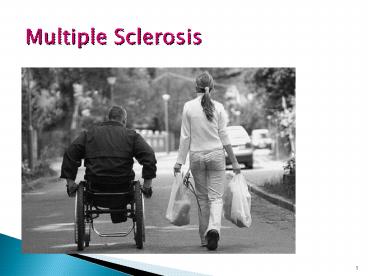Multiple Sclerosis - PowerPoint PPT Presentation
Title:
Multiple Sclerosis
Description:
... Amyotropic Lateral Sclerosis Multiple Sclerosis Huntington s Disease Alzheimer s Disease Huntington s Disease Myasthenia Gravis Guillian-Barre Syndrome ... – PowerPoint PPT presentation
Number of Views:444
Avg rating:3.0/5.0
Title: Multiple Sclerosis
1
Multiple Sclerosis
2
Concept Map Selected Topics in Neurological
Nursing
PATHOPHYSIOLOGY Traumatic Brain Injury Spinal
Cord Injury Specific Disease Entities
Amyotropic Lateral Sclerosis Multiple
Sclerosis Huntingtons Disease
Alzheimers Disease Huntingtons Disease
Myasthenia Gravis Guillian-Barre Syndrome
Meningitis Parkinsons Disease
PHARMACOLOGY --Decrease ICP --Disease /
Condition Specific Meds
ASSESSMENT Physical Assessment Inspection
Palpation Percussion
Auscultation ICP Monitoring Neuro Checks Lab
Monitoring
Care Planning Plan for client adls, Monitoring,
med admin., Patient education, morebased On
Nursing Process A_D_P_I_E
Nursing Interventions Evaluation Execute the
care plan, evaluate for Efficacy, revise as
necessary
3
Multiple Sclerosis
- Progressive
- Degenerative
- No Cure
- Affects nerve fibers in the brain and spinal cord
- Most common neurological cause of debilitation in
young people (ages20 - 40)
4
Pathology
- Probably autoimmune disease
- Antibodies and white blood cells attack the
proteins in the neurons myelin sheath
5
(No Transcript)
6
- Inflammation and injury to the sheath and
ultimately to the nerves that it surrounds
7
Whats in a Name?
- Multiple areas of scarring
- Hardening (Sclerosis) of nerve fibers...usually
in spinal cord, brain stem and optic nerves
8
Risk Factors
- More women than men
- More common in Caucasians
- Children of parents with MS have a higher rate of
incidence (15 50 depending on data source) - Geographic location --- Cold climate?
9
Northern Europe and the northern United States
have the highest prevalence, with more than 30
cases per 100,000 people
10
Diagnosis
- Based on the presence of CNS lesions that are
disseminated in time and space (neurologic
dysfunction in more than 2 sites at least one
month apart), with no better explanation for the
disease process - Because no single test is totally reliable in
identifying MS, and a variety of conditions can
mimic the disease, diagnosis depends on clinical
features supplemented by the findings of certain
studies such as - - MRI (visualize plaques)
- - CSF analysis (increases protein and slight
increase WBCs) - - Evoked potentials (define extent of disease
and monitors)
11
"Turbo FLAIR" MRI
12
Disease Progression Erratic !
- Because different nerves are affected at
different times, MS symptoms often worsen
(exacerbate), improve, and develop in different
areas of the body - This disease is unpredictable and varies in
severity
13
Hallmark Characteristics
- Intermittent damage to myelinintermittent
severity - Scarring and sclerosis of nerve fibers usually in
the spinal cord, brain stem, and optic nerves
14
Common S Ss
- Fatigue - Muscle Weakness
- Muscle Spasticity - Dysarthria
- Ataxia Balance Coordination difficulty
(dizziness / vertigo / spasticity of
extremities) - Lhermitte's sign (Electrical sensation down the
spine on neck flexion) - Dysphagia - Tinnitis
- Uhthoffs Sign (Exertion or Heat causes sudden
exacerbation of SS) - Numbness, tingling (Paresthesia) - Pain
- Bowel, bladder and sexual dysfunction
- Vision Disturbances (Blurring, blindness,
diplopia, patchy blindness)
15
Dysarthria
- "Slurred" speech
- Speaking softly or barely able to whisper
- Slow rate of speech
- Rapid rate of speech with a "mumbling" quality
- Limited tongue, lip, and jaw movement
- Abnormal intonation (rhythm) when speaking
- Changes in vocal quality ("nasal" speech or
sounding "stuffy") - Hoarseness
- Breathiness
- Drooling or poor control of saliva
- Chewing and swallowing difficulty
16
Common S Ss
- Emotionally labile
- Depression (suicide increased 7.5, usually in
first 5 years)
17
Course of Disease
- MS can progress steadily or cause acute attacks
(exacerbation) followed by partial or complete
reduction in symptoms (remission)
18
Increasing severity maybe minor plateaus or
remissions
Returns to baseline recovery
85
10-20
19
Collaborative Tx Goals
- Control symptoms
- Prevent complications
- Provide adaptive devices to increase mobility and
self-care
20
Meds specific for MS disease
- Avonex IM Weekly (interferon beta 1a)
- Betaseron SQ Daily (interferon beta 1b)
- Copaxone SQ Daily
- Rebif SQ given 3 x week
21
Symptom Management Meds
- Baclofen / Dantrium (for spasms)
- NSAIDS (for flu-like side effects and pain)
- Analgesics
- Corticosteroids (limit severity by modulating
immune response which decreases inflammation) - Antidepressants (like Prozac)
- Beta blockers for tremors (like Inderal)
- Anticonvulsants for parethesia (like Tegretol)
- Anticholinergics for bladder dysfunction
(Pro-Banthine)
22
Complications
- Bacterial infections (lung, bladder)
- Disturbed thought processes
- Impaired bladder bowel function
- Contractures
- Seizures
- Impaired mobility / speech / swallowing
- Sensory visual impairment
23
Prognosis
- In some people, MS is a mild illness, but, for
others, it results in permanent disability - Most patients have a normal lifespan































